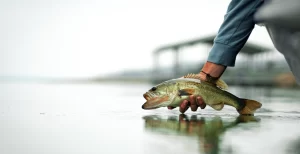Many bass anglers hit the water hard each spring, then put away their rods and reels before the fall bite starts to heat up. For those dedicated to pursuing bass into the latter half of the year, several critical factors impact their ability to find consistent success. Three key variables that significantly influence the fall bass bite are changing temperatures, bait migration, and shifting water levels.
Adapting to Changing Fall Conditions
Temperature Change
As highlighted by experts at Wired2Fish, temperature change is often the first consideration for anglers. As temperatures cool from summer highs, bass begin moving into shallower waters. This transition away from deep-water holding areas, where they resided during summer, makes catching bass in deeper spots more challenging. Anglers should adapt by using shallow-water tactics, targeting bass that are cruising the shallows in search of baitfish.
Additionally, as the water warms slightly during certain periods, baitfish will migrate upward from deeper waters, often clustering near the surface. This movement draws bass to areas like creek mouths and the backs of pockets, where they wait for the arrival of these floating baitfish.

Bait Migration
Baitfish migration is crucial to understand, especially during fall. In summer, baitfish often remain at depths of 20 to 40 feet. With the arrival of autumn, these baitfish rise higher in the water column. Creeks become highly productive spots as baitfish congregate in the backs of these areas. Pinch points and channel swings are also well-known for holding baitfish in the fall, making them prime locations for targeting bass.
Despite changing conditions, one rule remains constant: where the baitfish go, the bass will follow.
Water Levels
As fall progresses, many lakes experience a drop in water levels known as “lake drawdown,” bringing them to their “winter pool.” This drop can make much of the shallow-water structure and cover inaccessible. While these changing conditions may present challenges, bass will always find new areas to inhabit. Channel swings and deeper water pockets often become highly productive as fewer hiding spots remain. These deeper zones, left intact during lake drawdowns, can provide excellent opportunities for successful fishing.
Image/Source: WOS





